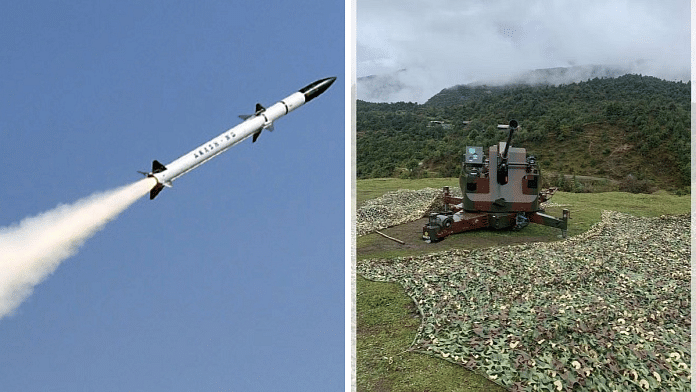New Delhi: Indian defence stocks have seen a remarkable surge since 7 May, propelled by the success of Operation Sindoor and riding on the expectation there will be greater defence spending by the Narendra Modi government in view of the current geopolitical scenario.
India and Pakistan were engaged in a swift but intense conflict after India launched Operation Sindoor in the intervening night of 6 and 7 May, hitting LeT and JeM terror infrastructure at nine locations in Pakistan and Pakistan-occupied Kashmir in retaliation to the 22 April terror attack on tourists in Pahalgam.
The terror attack was claimed by The Resistance Front (TRF), a frontal organisation of the Lashkar-e-Taiba (LeT). The TRF later withdrew the claim.
As details of the 7 May operation emerged, defence companies, especially those tied to airpower and missile systems, saw significant positive market movements from day 1 itself.
Significant gains were recorded for them on the National Stock Exchange (NSE) between May 7 and last Monday, 9 June. The rally continues.
Among Defence PSUs, Bharat Electronics Limited (BEL) surged from ₹310 on the day of the launch of the operation to ₹392 on Monday, a rise of 26.5 percent. The Bharat Dynamics Limited (BDL) jumped from ₹1,447 to ₹1,947 during the period, gaining a massive 34.5 percent. Similarly, the Hindustan Aeronautics Limited (HAL) moved from ₹4,470 to ₹5,012, marking a 12.1 percent increase.
In the private sector, ideaForge Technology, a drone manufacturer, saw its stock rise from ₹358 on 7 May to ₹586 9 June, soaring 63.7 percent. Solar Industries India, an ammunition and explosives supplier, climbed from ₹13,295 to ₹16,820, a gain of 26.5 percent. Similarly, Paras Defence and Space Technologies advanced from ₹1,369 to ₹1,607, up 17.4 percent.
Also Read: Defence stocks surge continues amid escalating India-Pakistan tensions since Pahalgam attack
The optimism
The investor optimism is primarily driven by the simmering India-Pakistan tensions despite a cessation of hostilities, and how well indigenous defence systems performed during the conflict and expectations of heightened defence spending.
Religare Broking Senior Vice President Ajit Mishra explained to ThePrint the rally is underpinned by both strategic imperatives and policy direction. “With the current defence spending at just 1.9 percent of the GDP, there’s ample scope for long-term growth, making the sector strategically attractive,” he said.
Dr Vikas Gupta, CEO of OmniScience Capital, added that budget projections suggest India’s defence allocation could rise to 2.2–2.3 percent of the GDP next year, with more than 70 percent of capital outlay earmarked for domestic procurement.
“The fact that these platforms are battle-tested makes a difference, not just for foreign buyers but also for Indian investors,” Gupta added.
During the 87-hour conflict, weapons that proved their effectiveness included the Soviet-era air defence systems such as the L/70 guns and Zu-23 mm guns which were upgraded by BEL. The air defence control and reporting center “Akashteer” developed by BEL for the Indian Army also performed effectively as did the homegrown Akash surface-to-air missile system manufactured by BDL.
These systems were instrumental in countering Pakistan’s extensive aerial incursions targeting civilian, religious and military infrastructure. Additionally, surveillance drones and kamikaze drones developed by ideaForge and Paras Defence also played a vital role during the conflict.
Adding to the market sentiment were decisions such as the government granting emergency procurement powers to the armed forces in mid-May.
Sources had told news agency ANI that the Defence Acquisition Council, chaired by Defence Minister Rajnath Singh, approved the sixth round of emergency procurements (EP-6), allowing purchases worth up to ₹40,000 crore. These include surveillance drones, kamikaze drones, long-range loitering munitions and artillery ammunition.
Furthermore, the government approved the execution model for the domestically produced fifth-generation Advanced Medium Combat Aircraft (AMCA) on 27 May. Under this model, state-run Hindustan Aeronautics Limited (HAL) will compete for the contract alongside private companies, which is said to be another factor aiding the windfall for defence players.
Hype-driven valuation spikes and storification bias
Despite the bullish sentiment, the analysts warn the current surge may be running ahead of fundamentals. “This is a classic sentiment play,” said Mishra. “Once a strong narrative forms, investors rush in, fearing they’ll miss out. That herd behaviour can push stocks up rapidly in the short term, even if underlying fundamentals haven’t changed much.”
In the past, similar national security flashpoints, such as the Balakot airstrikes in 2019 or the Galwan clash in 2020 sparked short-term rallies in defence stocks, only to correct once enthusiasm faded.
Dr V.K. Vijayakumar, Chief Investment Strategist at Geojit Financial Services, called the rally a textbook case of ‘storification bias’, where compelling headlines drive investment decisions more than earnings reality. “Yes, war-tested equipment adds credibility. But revenue concentration and operational bottlenecks haven’t changed overnight.”
“DPSUs are slow and overvalued. They still face long gestation cycles, delayed payments and tight margins due to their overdependence on a single buyer—the government,” added Vijayakumar.
He also added that while the structural story of the defence sector remains compelling, centred by rising indigenous procurement, battlefield validation and export ambitions, the investors must temper expectations in the short term.
(Edited by Ajeet Tiwari)
Also Read: Indian Navy flexes muscle in Arabian Sea with long-range precision anti-ship missile firings






